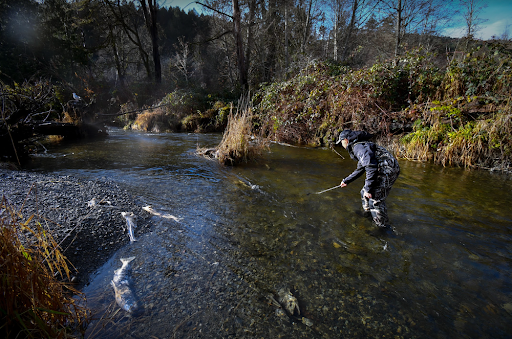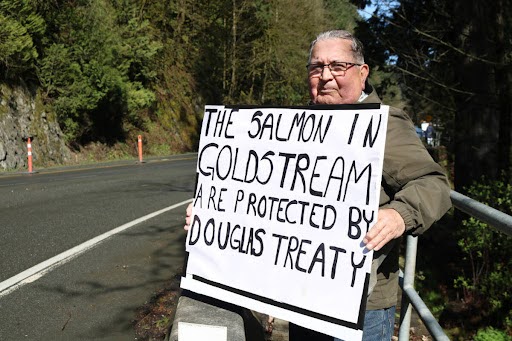Early counts show the Salmon population in the SELEK̵TEL̵, also known as Goldstream River, will increase in 2024, yet the Salmon need the support of the community to ensure continued survival.

As relatives and a critical traditional food source for W̱SÁNEĆ and KELŁOLEMEĆEN, it is important to protect Salmon of the Salish Sea. SELEK̵TEL̵ is a key spawning ground for Chum, Chinook, and Coho Salmon.
Due to an oil spill in 2011, the environmental disturbance caused by Bear Mountain Resort, and other disruptions caused by settler infrastructure and activity, the number of Salmon in SELEK̵TEL̵ has fallen dramatically. In 2020, there were 13,000 Chum Salmon and 600 Coho Salmon. In 2021, there were approximately 10,000 Chum Salmon and 1,300 Coho Salmon. In 2022, there were only 4,000 Chum Salmon and 500 Coho Salmon. And, in 2023, the number of Chum Salmon dropped to 1,600, while the number of Coho Salmon stayed the same. In each of these years, the number of Chinook Salmon – a critical species for KELŁOLEMEĆEN – has never exceeded 10.
Despite this downward trend, the numbers in 2024 are hopeful. Carl Olsen – a Tsartlip community member and long-time volunteer at Goldstream Hatchery – reports early counts show 1,300 Chum Salmon and 2,500 Coho Salmon in the initial days of the first Salmon run. More are expected as the first run continues and in the later run, which generally takes place in December. Children, teachers, and staff from school districts throughout the area are eagerly booking time to visit the Hatchery to witness this important event.
The improvement is no doubt in part due to the tireless efforts of Goldstream Hatchery, environmental protection advocates like the QENTOL, YEN / W̱SÁNEĆ Marine Guardians, and volunteers like Olsen. Beyond his work at the Hatchery, Olsen bolsters protection efforts by ensuring the next generation understands the traditional importance of Salmon. Recently, for example, Olsen worked with the Bayside School to show youth how to harvest Salmon and prepare them for smoking. Each child had an opportunity to try smoked fish at the end of the event. Olsen has also worked with the Sooke School District.
These efforts to protect and restore the Salmon population are an important part of the greater revitalization and protection of W̱SÁNEĆ culture. The work not only protects Salmon relatives as is required by natural law but also protects KELŁOLEMEĆEN, an endangered species that relies on Salmon for food. Protecting the Salmon also allows W̱SÁNEĆ to protect a traditional food source and the traditional practice of smoking Salmon.
However, a proposed expansion of the Malahat Highway by the Ministry of Transportation and Infrastructure (MOTI) threatens the Salmon population in new ways. According to Olsen, MOTI plans to remove 700 trees from SELEK̵TEL̵ as part of its work to build a divider between Malahat Highway’s two lanes. The project is anticipated to take four years.
This has both short-term and long-term impacts on the Salmon. In the short term, the construction will disrupt Salmon eggs and young Salmon, reducing Salmon numbers directly for each of the four years of construction and indirectly in the following years. Because Coho Salmon remain in the river for an entire year before moving on to the Sea, there is no safe time of year to disrupt SELEK̵TEL. In the long term, the removal of so many trees will increase the temperature of SELEK̵TEL̵ and expose it to the elements, making it a less ideal location for Salmon to spawn. These impacts disrupt W̱SÁNEĆ rights to hunt and fish “as formerly” as enshrined in law by the 1987 BC Supreme Court ruling in Claxton v. Saanichton Bay Marina.
In addition to further threatening the Salmon population, the proposed expansion of Malahat Highway impacts the eagles, owls, and other birds that nest in the trees MOTI plans to remove.
That’s why, for nearly two years, Olsen has travelled to SELEK̵TEL̵ to protest the proposed expansion. While he recognizes the need to reduce the number of cars on Malahat Highway, he encourages MOTI to seriously consider the many options that will not harm the Salmon, such as improving bus or rail-based transportation. “I’ve been there through rain, wind, snow, and ice, and I’m not going to stop,” Olsen says of his ongoing protest. “The Salmon have been quite resilient up until this point, but we can’t keep taking away and expect them to survive.”

Olsen calls upon community members to join him in protest any Tuesday from 10AM-12PM. In his words, “Our ancestors fought for what we have. Don’t give it away. If we do, we’re giving away something that is for our grandchildren and great-grandchildren.” He continues, “I challenge my communities to come and join me and learn more about what it is that we need to do.”
Interested parties should meet Olsen at 9:45AM at the Goldstream washrooms on any Tuesday morning. Signs will be provided.
To learn more about Salmon-protection efforts and more, subscribe to W̱SÁNEĆ Leadership Council’s newsletter.










